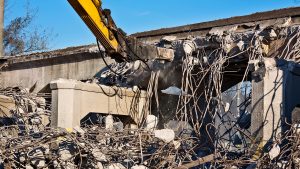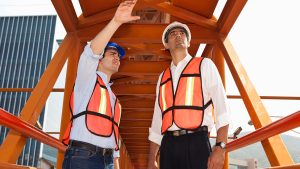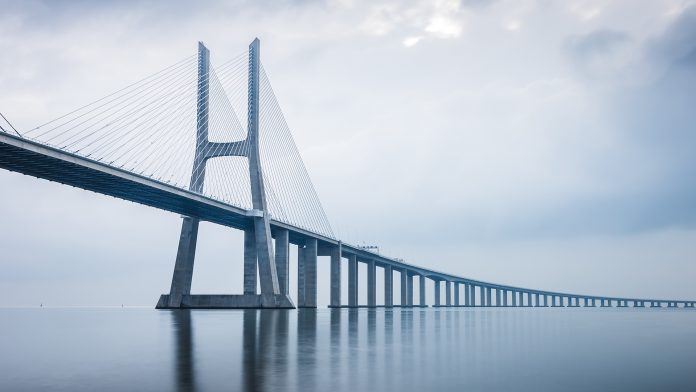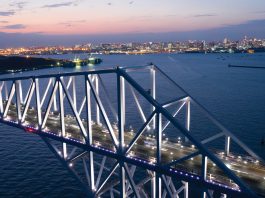EuroStruct President, Professor José C Matos, spoke to The Innovation Platform about the use of sensors (and other technologies) in bridge assessments, the importance of training for engineers and inspectors, and the need for additional funding to adequately maintain Europe’s bridge stock.
EuroStruct emerged from COST Action TU146 ‘Quality specifications for roadway bridges, standardisation at a European level (BridgeSpec)’, which aimed to meet European economic and societal needs by standardising the condition assessment and maintenance level of roadway bridges.
During this time, it was found that the work carried out during the COST Action could be further developed and its purpose could be extended to structures other than road bridges. With this in mind, it was decided to create the EuroStruct Association which aims to promote the understanding and advancement of practice on quality control of bridges and structures at a European level.
The Innovation Platform spoke to the EuroStruct President, Professor José C Matos, from the University of Minho, about such issues as the use of sensors (and other technologies) in bridge assessments, the importance of training for engineers and inspectors, and the need for additional funding to adequately maintain Europe’s bridge stock.

What would you say are some of the main challenges for Europe’s bridges – funding for maintenance, more traffic than originally expected, a lack of standardised condition assessments etc.?
There are many challenges facing the current stock of bridges – and indeed other structures – in Europe today. From my experience in both academia and research, and especially as Chair of the COST Action TU1406 (from which EuroStruct emerged), it has become clear that these challenges may vary from stakeholder to stakeholder, but there are also many which are across the board. One of such challenge relates to the proper management activities. As we saw recently with the bridge that collapsed in Genoa, Italy (Viadotto Polcevera), we are not immune from structures collapsing, or in many cases, from a loss of their functionality. In addition to the potential loss of life, such events can also have a dramatic impact on a country’s economy.
As such, I believe that more funding should be made available for the maintenance of bridges. Currently, the finances available are limited and, moreover, it is not possible to obtain funding to maintain all bridges simultaneously. Because of this, it is crucial that we develop precise and standardised assessment and decision-making procedures, to be integrated in proper management systems.
Indeed, this was a point that we originally raised in COST Action TU1406, and one that we have carried over into EuroStruct. In this context, there is perhaps an analogy to be drawn between such structures and the human body, i.e., inspectors are the first people to come into contact with bridges when an assessment is being performed. These can be seen as akin to the doctors who will provide a patient with an initial consultation in order to formulate a diagnosis. But for both of these professionals to make an accurate appraisal of the ‘patient’ and its afflictions, they need the right tools. In the healthcare setting, non-invasive technologies are often employed to this end, resulting in a precise diagnosis. The same is required for engineers who are assessing the health of a given structure. We therefore need to ensure that there is a continued investment in developing these tools and technologies because they will result in more precise and useful data on each bridge performance, and this can be used to support informed-based decisions regarding next steps.
In addition to the condition and performance of a bridge, we also need to know how it will react to changes in general circumstances – such as an increase in traffic flow (or, indeed, a decrease, as has been seen during the COVID-19 pandemic) – or, perhaps more importantly, how it will respond to extreme events. Such events can include earthquakes (e.g. as some bridges were built in areas which were not known to be prone to earthquakes), climate-change related events such as flooding, and so on.
In order to better understand how Europe’s bridges can be adapted to such events, we need to invest in detailed vulnerability maps, from which we can build fragility curves for different hazards. Of course, if these activities reveal that one bridge is at risk, then we will then need to look towards adapting it to the new realities by using new materials and technologies. It is therefore important that these are also funded, so that they are available when needed.

What are your thoughts on how new technologies are being developed, such as sensors etc., which could help to monitor bridge safety? Is there enough funding for such R&D, and does enough of this research become transformed into applications?
Yes, many sensors which can be used in bridge and other structures assessment are already available on the market. Indeed, the sensors available in most smartphones have sufficient capabilities – and as they become more widely available, the cost continues to decrease while accuracy levels rise. Of course, sensors do have a central role to play in monitoring the performance of bridges and in almost all instances the cost involved in applying them is more than recouped by the owner in terms of catching issues before they become critical. That being said, sensors, no matter how ‘smart’ or advanced, will never replace the expertise of engineers who should always be first on-site when inspections or assessments are required.
There is perhaps an issue regarding how such sensors are used and, moreover, how the data they generate is utilised in the management of a bridge, or a bridge stock, which includes both the structure’s general maintenance but also understanding how vulnerable it is to extreme events. As such, the data needs to be made available to engineers rather than simply informaticians who are increasingly coming to replace structural engineers in these roles, which is a worrying trend. To go back to the human health analogy, we would not trust someone versed in data analysis to look after a patient, no matter how extensive their expertise; that role would still fall to the doctor or physician, and the same is true for bridges, i.e., while informaticians no doubt have a role to play in assisting with data analytics, decisions around the health/performance of a bridge should be made by qualified engineers.
This perhaps raises a final point – it is fundamental that bridge and structural engineers receive the right training and are suitably qualified, and for that to happen we need to ensure that training programmes are funded and available. Indeed, this was an investment made within COST Action TU1406, and now through EuroStruct.
Given that Europe’s infrastructure is ageing, with many (if not most) of the bridges being constructed in the 1950s, is there a need for more than just an infrastructure upgrade, and perhaps for replacement structures utilising new materials, for instance?
There is an element of controversy here because most bridges and structures are designed to have a life of 100 years, and yet many that exist today are older than that – some quite significantly so. And while the term ‘life cycle’ is often used, a better term is perhaps ‘lifetime’, as that does not necessarily imply a definitive beginning and an end.
For some bridges, there may come a time when replacement with a new bridge, using new materials which are, for instance, more durable, is cheaper than maintaining the existing one. Of course, these materials may also have a role to play in the maintenance of existing structures, meaning that we are able to combine the use of research and innovation with the existing built environment, which is always a positive thing. There are some exceptions here, of course, such as heritage bridges for which a special care is needed due to its unforgettable value.

What do you believe is needed for progress in structural engineering regarding bridges, and what role will EuroStruct continue to play?
The physical inspection of bridges will always be needed; this is crucial for their maintenance and management, as well as when it comes to upgrading old stock or demolishing and building new ones. In terms of R&D funding, we need to continue to fund the development of new technologies such as sensors, as well as UAVs which can aid in inspections. But we also need to ensure that there is a budget for materials. Perhaps the two most important areas in terms of investment are the way that data is processed and managed, and the training that is made available to engineers.
Of course, EuroStruct does not fund research projects. We do, however, take part in those that are in line with our aims in terms of the quality control of bridges and structures. It should also be noted that we have expanded the scope of EuroStruct so that we not only cover bridges, but a variety of other structures, too; we believe that the entire built environment needs to have the right quality control procedures in place.
We are currently working to develop guidelines on where funding should be allocated – including many of the areas we have discussed above and where the priorities should be in terms of the management of the built environment in Europe.
Moving forward, we will promote online training courses for engineers from all over the world, although mostly from Europe. These will focus on ensuring that engineers are able to make the right decisions in terms of the management of the structure they are assessing.
Finally, we will also promote workshops, conferences, and other events (e.g. Live Talks), where we hope to be able to bring together the different stakeholders, who are all concerned with ensuring that Europe’s built environment is as sustainable as possible, together in one place to share skills, knowledge, and best practices.
Professor José C Matos
President
EuroStruct
+351 253 510 200
jmatos@civil.uminho.pt
https://eurostruct.org/
Please note, this article will also appear in the third edition of our new quarterly publication.









